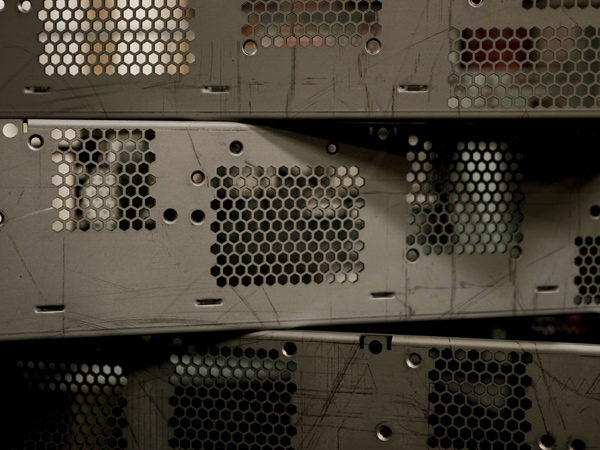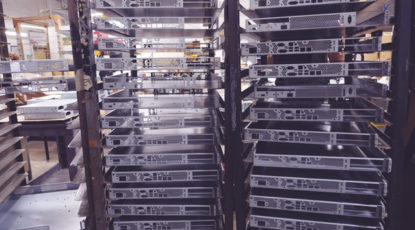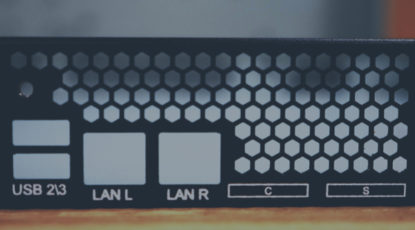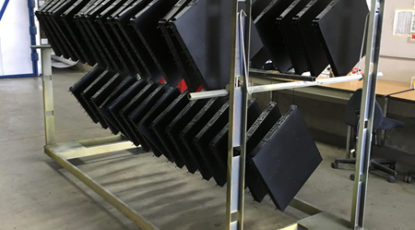Electronic Enclosures (Computer Server Chassis and Racks)
At CNC Machining Hong Kong, Incorporated we specialize in precision sheet metal fabrication services. We provide fabricated sheet metal solutions to customers across a diverse set of industries, including server chassis and racks.
A server chassis—also referred to as a server casing or server case—is a metal structure used to house and organize individual servers and related equipment within a single unit. It is designed to reduce the amount of space needed for server systems while still allowing for easy access. The forms available include tower and rack variants.
A server rack is a server chassis featuring a frame that supports the weight and volume of mounted servers, switches, and other equipment. It is available in an open-frame design that allows for easier cable management, greater airflow, and better organization or a fully enclosed design that provides greater protection to the internal components from external factors (rack enclosures).
Both server chassis and server racks find use in facilities that need to house multiple servers or pieces of computer hardware. Typical applications include:
- Server rooms and data centers
- Telecommunications equipment rooms
- Factory floors, security video centers, and other industrial locations
Key Considerations for Server Chassis and Server Racks
When choosing a server chassis or rack for an application, there are several factors to keep in mind to ensure the completed structure properly supports the internal components and accommodates management, organization, and maintenance operations. Some of the key considerations include:
Size
The dimensions of the server chassis and rack need to be able to fit the space allotted for use but also need to hold all of the servers and other equipment safely. Depending on the facility, the new structures can be integrated into existing enclosures or built to be free-standing.
Power
Servers need adequately sized and reliable power supplies to ensure proper and consistent operation. The chassis and rack component should accommodate the power supply required and allow for easier organization and maintenance of the connections (e.g., power cords and wires).
Speed
Chassis and racks need to provide adequate support to the equipment both structurally and operationally. By selecting ones that support the needs of the server—e.g., multiple network adapters and CPUs—it mitigates the risk of the server section becoming a bottleneck in regard to speed and performance.
Assembly
Structures that do not require the use of tools during assembly and installation facilitate quicker and easier setup and maintenance operations. In addition to not having to invest additional tools, chassis and racks with tool-less assembly requirements are better for confined or limited-space environments.
Ventilation
Servers generate significant amounts of heat, necessitating the maintenance of adequate airflow and ventilation to prevent overheating the sensitive internal components. Open-frame structures or closed structures with fans and cooling systems serve as an ideal solution to this issue.
Operating System (OS) Compatibility
Server units come in multiple forms, each with different operating systems. When choosing a chassis or rack, it is important to ensure that the one selected has hardware that is compatible with the OS of the server components.
Disk Swapping
Hot-swappable disk drives allow personnel to add new devices and replace damaged ones without powering down the whole server. This functionality is crucial for maintaining hardware without having to halt operations for maintenance.
Expandability
A good server chassis or rack supports continued growth. This factor can include options for additional power configurations, CPUs, and RAM chips.
Redundancy
Integrating failsafe measures, such as backup power supply units (PSUs) or network interface cards (NICs), minimizes downtime in the event of a failed primary unit. Having these secondary components in places allows personnel to redirect business operations to the backup while repairing or replacing the primary component.
Components of Server Chassis and Server Racks
Server chassis and racks consist of many different parts, including the following:
- Casters. These attached wheels facilitate movement during installation and maintenance.
- Doors. These front and rear doors can feature vents that allow for adequate airflow while providing better security by limiting line-of-sight visibility or accommodating locks.
- Hinged wall brackets. Hinged wall brackets are used in wall-mounted racks to offer easier access to rear components.
- Levelers. Once a server unit is in position, levelers can be used in place of casters to provide better support and level management.
- Locks. Servers and racks should be protected with keyed or combination locks to protect the servers and the information on them.
- Mounting holes. Chassis and racks feature many different mounting holes of various shapes—e.g., square, threaded, or round—for sturdy assembly.
- Roofs. These roof panels may have ventilation, holes for cables, and other features that simultaneously protect the inner units and allow for care or maintenance.
- Side panels. Side panels are an optional feature. Modular chassis or racks may have side panels on the exterior sides and no side panels inside—a design that allows for better airflow throughout the structures.
- Tool-less mounts. Many chassis and racks have keyhole slots that simplify assembly and installation.
High-Quality Custom Server Chassis and Servers Racks From CNC Machining Hong Kong
For over 50 years, CNC Machining Hong Kong has served industry with high-quality fabricated sheet metal solutions. For industries that use server units, we offer capabilities for custom server chassis and racks. Our applicable fabrication services include the following:
- CNC punching
- Laser cutting
- Precision forming
- Powder coating and masking
- Hardware installation
As an ISO 9001:2015 certified company, our team is dedicated to ensuring the quality of every product and service delivered. Additionally, we maintain certification in welding and spot welding according to MIL-SPEC standards 1595 and W68581, respectively, to guarantee quality welds in every product that requires them.
For more information about this project or the processes used to create it, contact us directly.
Custom Rack Mount Chassis Specifications
- Project Name & Description
-
Custom Rack Mount Chassis
High-Accuracy Complex Sheet Metal Forming
- Capabilities Applied/Processes
-
CNC Punching (in-turret forming), Laser cutting, precision forming, hardware installation, complex powder coat/masking, custom made-in-house silkscreen artwork.
- Equipment Used to Manufacture Part
-
Amada EMK 12’ x 4’ 33 Ton Electric turret punch, Mitsubishi 6000W Fiber Laser 10’ x 5’, Amada HDS 1703 10’ CNC press brake, Haeger hardware presses.
- Overall Part Dimensions
-
20” x 24” x 3”
- Tightest Tolerances
-
±.010” (hole tolerance ± .003”)
- Tightest Tolerances
-
±.010” (hole tolerance ± .003”)
- Material Used
-
18GA Electrogalvanized steel
- Material Finish
-
Fine Texture Powder Coat + epoxy silkscreen ink
- Industry for Use
-
Federal – Electronics
- In Process Testing/Inspection Performed
-
Flat Pattern inspection, first piece inspection for each operation in process, sample based mechanical inspection, 100% final visual inspection
- Volume
-
1-1000
- Delivery/Turnaround Time
-
4 weeks
- Delivery Location
-
HONG KONG






